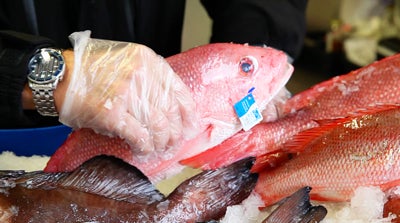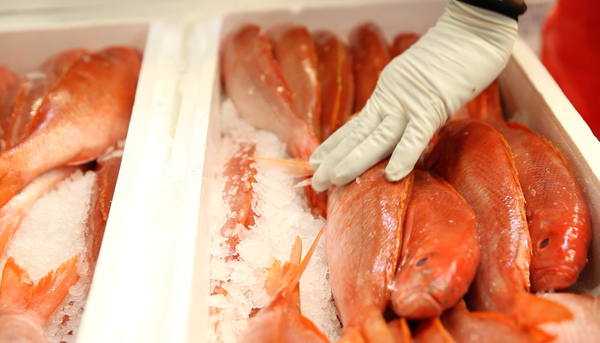This article was published in Scientific American’s former blog network and reflects the views of the author, not necessarily those of Scientific American
I’ve got a crazy idea:
What if, when you buy a thing, then that thing is actually the thing that you thought you were buying?
When it comes to seafood, such an idea is apparently a bit of a reach. A new report out by Oceana (full disclosure—I’m one of the report authors) looking at seafood fraud worldwide found that out of 25,000 samples in more than 200 studies conducted in 55 countries, roughly one in five were mislabeled, on average.
On supporting science journalism
If you're enjoying this article, consider supporting our award-winning journalism by subscribing. By purchasing a subscription you are helping to ensure the future of impactful stories about the discoveries and ideas shaping our world today.
Besides the basic fairness and honesty that customers expect in most retail situations (“Hey, I paid for red snapper. Shouldn’t I get red snapper?”), seafood fraud has serious economic, ecological, and health consequences.
Illegal, unregulated, and unreported (IUU) fishing is an estimated $23 billion industry, and one of the greatest threats to marine biodiversity and abundance. Seafood mislabeling can hide that. The Oceana report highlighted cases of fraud ranging from individual swaps of cheaper fish like cheaper haddock being sold as more expensive cod, to an investigation currently underway for a New England supplier allegedly covering up roughly $154 million in illegally caught and mislabeled seafood. Instances of economically motivated mislabeling like these defraud consumers, and undercut honest fishermen and businesses.
There are reasons behind laws prohibiting the catch of certain fish in certain places at certain times. Our fisheries are under extreme pressure, and to bring them back to their former abundance, fisheries are must be managed with scientifically-based catch limits. Some species of fish are threatened with extinction, and are prohibited from being caught, or some areas are set off-limits during certain times. Illegal fishers all over the world flout these rules, and those ill-gotten fish enter the supply chain. This is a serious problem. Oceana’s review of fraud studies found that 12 percent of the species substituted are considered critically endangered, endangered, or vulnerable to the threat of extinction by the International Union of the Conservation of Nature.
Some species of fish carry specific health risks that consumers might want to avoid. Probably the grossest example of this is escolar, which has been frequently sold as “white tuna” in sushi restaurants in the United States. Escolar contains a naturally-occurring “gempylotoxin,” which can cause a waxy bowel discharge (!!), nausea, vomiting, and stomach cramps. Most folks don’t want to finish off their sashimi experience with a sake bomb, only to have an entirely different kind of bomb later that evening.
(Diarrhea. I’m talking about nasty, greasy, orange-colored diarrhea)
Clearly, there are plenty of reasons for being discerning in one’s seafood choices. But mislabeling denies consumers their ability to make responsible (or safe) decisions. The answer to this problem, argues Oceana, is to enact full-chain traceability for all seafood. This means that information about how and where fish are caught (or harvested if farmed), should follow seafood from the boat to the end consumer. Also, species-specific information about that seafood should accompany it through every step of the seafood supply chain, and be available to the end consumer.
Traceability and more information to the consumer have promise in reducing seafood fraud. The Oceana report examined fraud rates before and after anti-IUU, fisheries control rules, seafood traceability and labeling regulations went into effect in the European Union. Though the regulations are young, and vary in their implementation and enforcement, they are far more comprehensive than anything currently in place in the U.S., and they appear to be reducing mislabeling. Before the first rules went into effect in 2010, the average mislabeling rate (weighted to study sample size) in the EU was more than 20 percent. By 2015 those average rates had fallen to roughly 8 percent.
The Obama administration’s Presidential Task Force on combatting IUU Fishing is in a position to make similar systems a reality in the U.S. But the task force’s proposed rule limits traceability requirements to a handful of species deemed at-risk of seafood fraud and illegal fishing, and traceability would extend only from the boat or aquaculture farm to the U.S. Border. In another report, Oceana described dozens of cases since 2001, in which seafood was found or suspected to be mislabeled, that would not be covered by the Task Force’s proposed rule. Because of this, Oceana is calling for the final rule, expected sometime this year, to include a timeline for expanding traceability requirements to all seafood. Additionally, Oceana is asking the Task Force to continue its work to extend traceability throughout the entire seafood supply chain, not just from the boat to the border.

Credit: OCEANA Patrick Mustain
Not everyone wants full-chain traceability. In a hand wringing blog post, the National Fisheries Institute, a trade association for the seafood industry, objected to Oceana’s report, decrying a non-existent claim that 20 percent of all seafood is mislabeled (nowhere does the report claim that 20 percent of all seafood is mislabeled--Oceana simply reported the rates of mislabeling in the samples that were tested in the studies it reviewed). NFI pointed to an FDA investigation that found that 85 percent of fish tested at wholesale was labeled correctly. Which means 15 percent was not.
Most consumers and seafood buyers are probably not ok with a 15 percent mislabeling rate (especially with the serenity of one’s bowels on the line). This is a pretty straight-forward ask: Let’s demand a supply chain that is transparent and accountable, and plenty of folks in the industry agree. In an interview earlier this year, MJ Gimbar, chief fishmonger at Black Restaurant Group in Washington, DC told me:
“If someone is having issues with traceability, most of the time they’re doing something wrong that they shouldn’t be doing. I don’t think anyone in the industry should be against traceability . . . because it levels the playing field. I think if you’re doing the right things you should want to show that. If you’re doing the wrong things, you probably don’t want to show that, and that’s not people that we want to do business with anyway.”
And why is that? He went on:
“People deserve to get what they pay for, bottom line.”
Call me crazy, but I agree with him.
